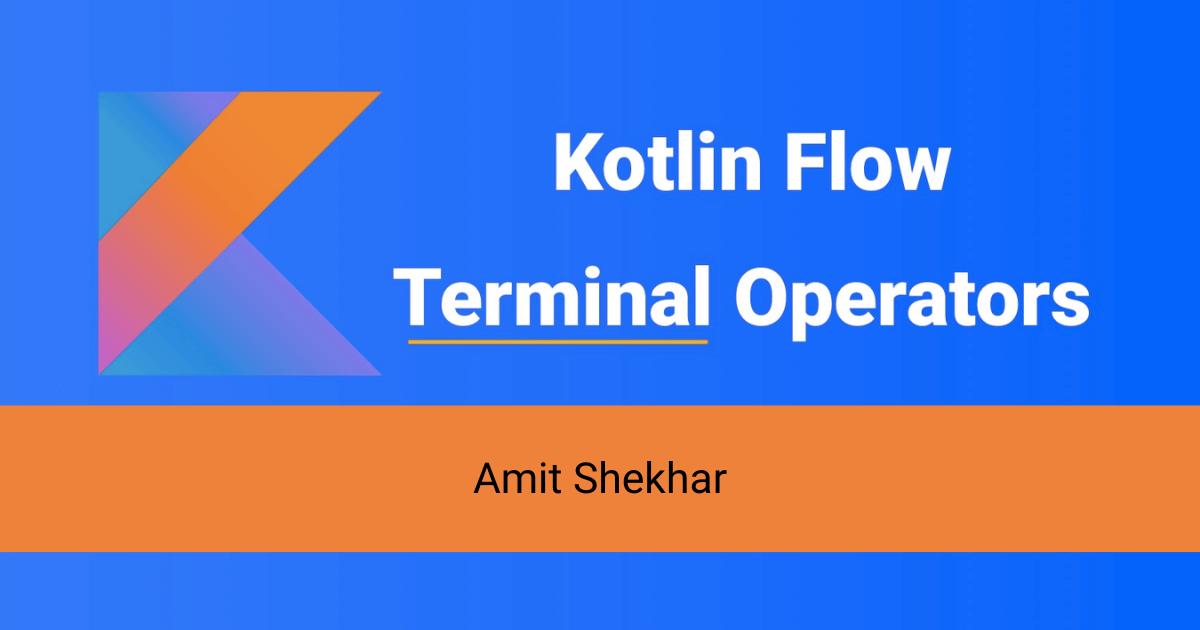Terminal Operators in Kotlin Flow
- Authors
- Name
- Amit Shekhar
- Published on
I am Amit Shekhar, Co-Founder @ Outcome School, I have taught and mentored many developers, and their efforts landed them high-paying tech jobs, helped many tech companies in solving their unique problems, and created many open-source libraries being used by top companies. I am passionate about sharing knowledge through open-source, blogs, and videos.
Join Outcome School and get high paying tech job: Outcome School
Before we begin, we’d like to mention that we’ve launched our YouTube channel. Subscribe to the Outcome School YouTube Channel.
In this blog, we are going to learn about the Terminal Operators in Kotlin Flow. The Flow APIs in Kotlin Coroutines are very helpful when it comes to handling the stream of data.
This blog is a part of the series I have written on Flow API in Kotlin:
- Mastering Flow API in Kotlin
- Creating Flow Using Flow Builder in Kotlin
- Terminal Operators in Kotlin Flow - YOU ARE HERE
- Cold Flow vs Hot Flow
- StateFlow and SharedFlow
- Long-running tasks in parallel with Kotlin Flow
- Retry Operator in Kotlin Flow
- Retrofit with Kotlin Flow
- Room Database with Kotlin Flow
- Kotlin Flow Zip Operator for Parallel Multiple Network Calls
- Instant Search Using Kotlin Flow Operators
- Exception Handling in Kotlin Flow
- callbackFlow - Callback to Flow API in Kotlin
- Unit Testing ViewModel with Kotlin Flow and StateFlow
Let's get started.
What are Terminal Operators?
Terminal operators are the operators that actually start the flow by connecting the flow builder, operators with the collector.
For example:
(1..5).asFlow()
.filter {
it % 2 == 0
}
.map {
it * it
}.collect {
Log.d(TAG, it.toString())
}
Here, collect is the Terminal Operator.
So, the most basic terminal operator is the collect operator which is the Collector.
So, if you just write the following, the flow will not start:
(1..5).asFlow()
.filter {
it % 2 == 0
}
.map {
it * it
}
You must use the terminal operator to start it, in this case, collect.
Let's see another Terminal Operator which is reduce Operator.
reduce: apply a function to each item emitted and emit the final value
val result = (1..5).asFlow()
.reduce { a, b -> a + b }
Log.d(TAG, result.toString())
Here, the result will be 15.
Explanation:
At the initial stage, we have 1, 2, 3, 4, 5 which are going to be emitted.
Initially a = 0 and b = 1 which will keep on changing based on the steps.
Step 1:
a = 0, b = 1
a = a + b = 0 + 1 = 1
Step 2:
a = 1, b = 2
a = a + b = 1 + 2 = 3
Step 3:
a = 3, b = 3
a = a + b = 3 + 3 = 6
Step 4:
a = 6, b = 4
a = a + b = 6 + 4 = 10
Step 5:
a = 10, b = 5
a = a + b = 10 + 5 = 15
This is how the result will be 15.
This was all about the Terminal Operators.
Prepare yourself for Android Interview: Android Interview Questions
That's it for now.
Thanks
Amit Shekhar
Co-Founder @ Outcome School
You can connect with me on:
Follow Outcome School on:
